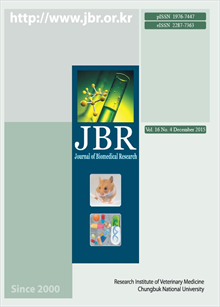간행물
Journal of Biomedical Research

- 발행기관 충북대학교 동물의학연구소
- 자료유형 학술지
- 간기 계간
- ISSN 1976-7447 (Print)2287-7363 (Online)
- 수록기간 2000 ~ 2015
- 주제분류 의약학 > 수의학 의약학 분류의 다른 간행물
- 십진분류KDC 528DDC 636
권호리스트/논문검색
Vol. 10 No. 3 (2009년 9월) 4건
1.
2009.09
구독 인증기관 무료, 개인회원 유료
Beom Jun Lee, Jong Soo Kim, Bong Su Kang, Hyun Ji Park, Dang-Young Kim, Seon-Young Hwang, Sang Yoon Nam, Young Won Yun
Although hair disorders are not life threatening, a lot of people who suffer hair loss and/or hair thinning is increasing in accordance with changes in lifestyle and nutritional balance. The aim of this study was to examine the effects of herbal extracts on hair regrowth in C3H/HeJ mice. There were 6 experimental groups including distilled water (D.W.), 50% ethanol (a vehicle control), 3% minoxidil (a positive control), and 3 kinds of herbal extracts mixtures (C, D & E). The test compounds included followings; C : Glycyrrhizae radix, Rhei Rhizoma, Cornus officinalis and Sesami semeni, D : Viticus fructus, Pulsatilla chinensis, Gardenia fructus and Artemisiae argyi herb, E : Swertia pseudo-chinensis, Sophora flavescens Scutellaria baicalensis and Salvia miltiorrhiza. The animals were shaved with an electric clipper. The test compounds were daily treated to dorsal skin with 0.2 ml per mouse for 3 weeks. The topical application of the E test solution accelerated hair regrowth after 10 days faster than that of the positive and vehicle controls. The activities of alkaline phosphatase (ALP) and γ-glutamyl transpeptidase significantly were increased in all the treatment groups after 3 weeks, compared with D.W. group. Especially, the E test solution notably increased ALP activity compared with positive or vehicle control group. Epidermal growth factor (EGF) and vascular endothelial growth factor (VEGF) were increased in all the treatment groups after 3 weeks compared with D.W. group. These results suggest that the herbal extracts have hair regrowth effect by increasing enzyme activities and growth factors and it can be useful for treatment for alopecia in humans.
4,000원
2.
2009.09
구독 인증기관 무료, 개인회원 유료
Yun-Bae Kim, Sun Hee Lee, Goeun Yang, Yun-Hui Yang, Dae-Kwon Bae, Dongsun Park, Tae Kyun Kim, Young Jin Choi, So Young Choi, Sung-Soo Koong, Yoon-Bok Lee, Hyun-Gu Kang
Effects of Vegemil® containing soybean proteins and isoflavones on the growth and bone density of broiler chickens were investigated. One-week-old male and female Arbor Acres broiler chickens were fed on Vegemil® A containing 3% soybean proteins and 162 ppm isoflavones, instead of water, for 30 days and their growth indices (body weight, leg weight and femur length) and bone density were analyzed. The body weight gains in male and female chickens were increased by 15.6% and 31.7%, respectively, following feeding Vegemil® A compared to normal water. Vegemil® A increased leg weight as well as femur length of females by 22.9% and 15.0%, respectively. In addition, Vegemil® A feeding enhanced femoral bone density by 21.3% in comparison with water feeding. Therefore, it is suggested that Vegemil® A not only facilitates body growth, but also strengthens bone density of normal chickens, and that it could be a promising candidate for the improvement of infant growth and for the prevention of menopausal osteoporosis.
4,000원
3.
2009.09
구독 인증기관 무료, 개인회원 유료
Histologic and immunohistochemical features of canine skin tumours originated from epithelial stem cells were described. The tumors were trichogenic trichoblastoma, trichoepithelioma, sebaceous adenoma, hepatoid gland adenoma and epithelioma, and basal cell tumour. All of the tumors expressed both AE1/AE3 and cytokeratin 5/8, whereas cytokeratin 7 and vimentin not at all. Neuron-specific-enolase was strongly positive in follicular tumours, whereas slightly in basal cell tumour. Moreover, chromogranin A was expressed slightly only in trichogenic trichoblastoma and trichoepithelioma. Since the morphological similarities between these tumors, immunohistochemistry is one of useful tools for differential diagnosis. From the immunohistochemistry data, we conclude that cytokeratins, vimentin and NSE play a main role in the evaluation of canine skin tumours originated from epithelial skin stem cells histogenesis.
4,000원
4.
2009.09
구독 인증기관 무료, 개인회원 유료
Germinated rough rice (GRR) has many healthy effects such as antioxidant activity, inhibition of chronic inflammatory disease and prevention of vascular disease. In this study, germinated Korean rice sample which was planted in 2008 from Korean Rural Development Administration was used. The purpose of this study was to recognize the effect of the ethanol extract of GRR on the ischemic damage of skeletal muscle. Right femoral artery ligation was performed to induce ischemic condition in mice and the mixed basal diet with the ethanol extract of GRR at various levels (100, 200, and 400 mg/kg diet) was given for 2 weeks. After the mice were sacrificed, the hind limb muscle samples of the mice were fixed, sectioned, stained with Haematoxylin-Eosin (H&E), Masson’s trichrome, and performed for Immunohistochemistry (IHC) for caspase-3. In histopathological findings of H&E and Masson’s trichrome stain, the treatment of GRR at the level of 400 mg/kg diminished fibrosis and necrosis in the muscle compared to the control. The expression of caspase-3 protein was also decreased by the treatment of GRR at the level of 400 mg/kg compared to the control. These results suggest that the ethanol extract of GRR may have a protective effect against muscle damage during the ischemia in skeletal muscle of hindlimb.
4,000원

